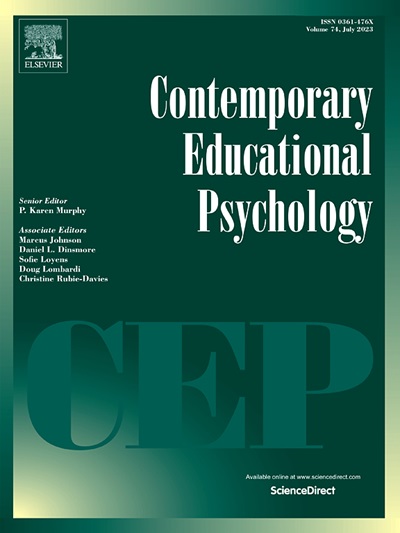语义网络分析在学生个体思考-朗读数据中的三种应用
IF 3.8
1区 心理学
Q1 PSYCHOLOGY, EDUCATIONAL
引用次数: 0
摘要
学生在学习过程中的数据,如思考-扩音或写作,经常被编码为策略或动作的使用,但较少被编码为学生使用了哪些知识。然而,分析这些产品的内容可以获得许多有价值的信息。语义网络分析是一种很有前途的分析学生产品内容的技术,在政治学、传播学、信息科学和其他一些社会科学学科中得到了更广泛的应用。我们查阅了有关个人语义网络分析(SemNA)的少量文献,以确定哪些网络分析指标可能适用于相关成果。我们讨论了科学教育中的知识整合(KI)框架,该框架侧重于学生知识的数量和结构,因此特别适合用 SemNA 指标进行测试。然后,我们用文献综述中发现的指标重新分析了三组已发表的本科生学习生物学入门的思考-朗读数据。结果发现,节点和边的数量、度数和度间中心性、直径和平均距离与测试后的理解得分有显著关系。在聚类数、LCC 和密度方面,发现了可能由于特定文本特征而导致的不一致结果;在 PageRank 中心性和中心化程度方面,发现了无效结果。KI 框架的基本原理得到了支持--信息量(节点)、连接(边、平均度)、关键观点(度和间中心性)和因果链长度(平均距离和直径)与测试后的理解力有关,但与密度或 LCC 无关。本文讨论了不同数据集之间存在微小差异的可能原因,并提出了其他理论和衡量标准。本文章由计算机程序翻译,如有差异,请以英文原文为准。
Three applications of semantic network analysis to individual student think-aloud data
Student during-learning data such as think-alouds or writing are often coded for use of strategies or moves, but less often for what knowledge the student is using. However, analyzing the content of such products could yield much valuable information. A promising technique for analyzing the content of student products is semantic network analysis, more widely used in political science, communication, information science, and some other social science disciplines. We reviewed the small literature on semantic network analysis (SemNA) of individuals with relevant outcomes to identify which network analysis metrics might be suitable. The Knowledge Integration (KI) framework from science education is discussed as focusing on amount and structure of student knowledge, and therefore especially relevant for testing with SemNA metrics. We then re-analyze three published think-aloud data sets from undergraduate students learning introductory biology with the metrics found in the literature review. Significant relations with posttest comprehension score are found for number of nodes and edges; degree and betweenness centrality; diameter, and mean distance. Inconsistent results possibly due to text-specific features were found for number of clusters, LCC, and density, and null results were found for PageRank centrality and centralization degree. Basic principles from the KI framework are supported—amount of information (nodes), connections (edges, average degree), key ideas (degree and betweenness centrality) and length of causal chains (mean distance and diameter) are related to posttest comprehension, but not density or LCC. Possible explanations for slight variations across data sets are discussed, and alternative theories and metrics are offered.
求助全文
通过发布文献求助,成功后即可免费获取论文全文。
去求助
来源期刊

Contemporary Educational Psychology
PSYCHOLOGY, EDUCATIONAL-
CiteScore
16.50
自引率
3.90%
发文量
74
期刊介绍:
Contemporary Educational Psychology is a scholarly journal that publishes empirical research from various parts of the world. The research aims to substantially advance, extend, or re-envision the ongoing discourse in educational psychology research and practice. To be considered for publication, manuscripts must be well-grounded in a comprehensive theoretical and empirical framework. This framework should raise critical and timely questions that educational psychology currently faces. Additionally, the questions asked should be closely related to the chosen methodological approach, and the authors should provide actionable implications for education research and practice. The journal seeks to publish manuscripts that offer cutting-edge theoretical and methodological perspectives on critical and timely education questions.
The journal is abstracted and indexed in various databases, including Contents Pages in Education, Australian Educational Index, Current Contents, EBSCOhost, Education Index, ERA, PsycINFO, Sociology of Education Abstracts, PubMed/Medline, BIOSIS Previews, and others.
 求助内容:
求助内容: 应助结果提醒方式:
应助结果提醒方式:


